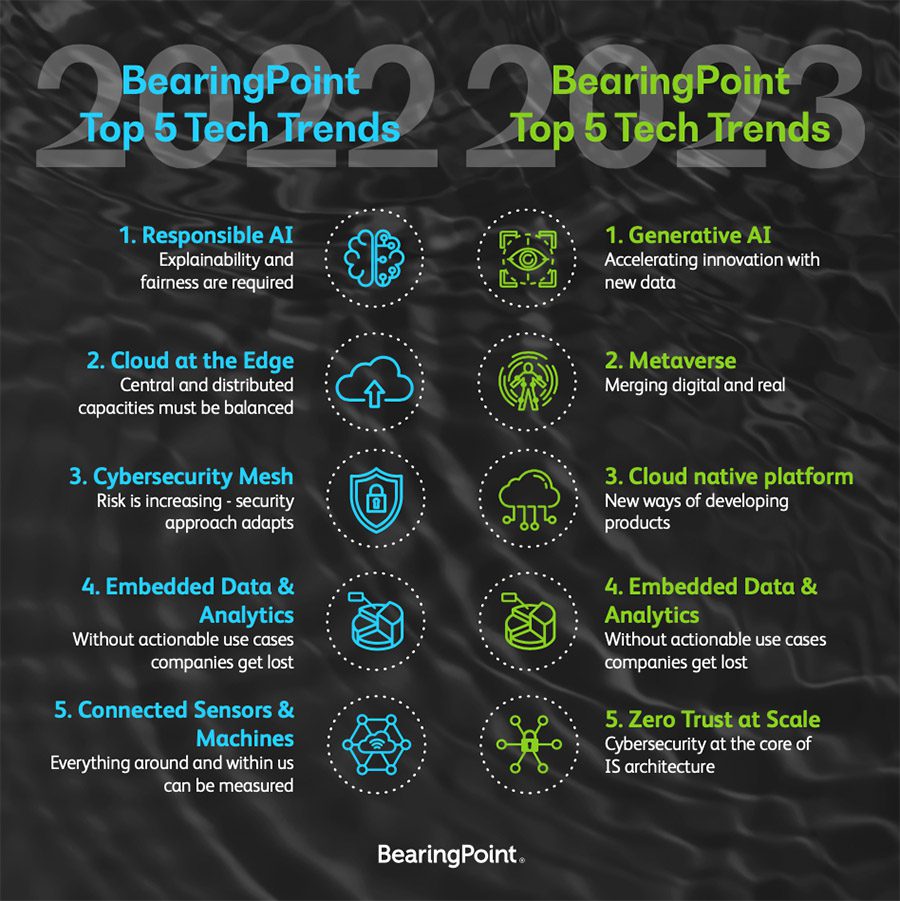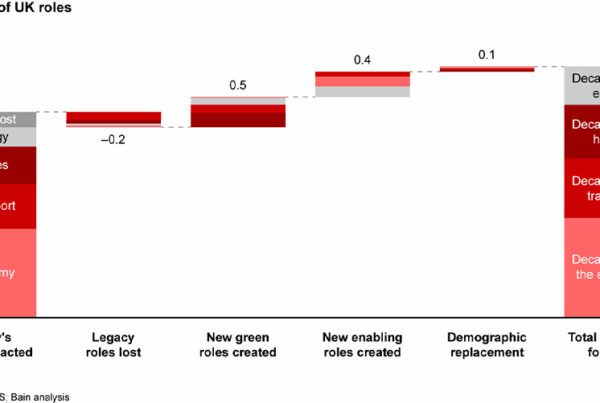With many businesses turning to technology to cut costs and drive revenues amid the recession, five key trends look set to dominate the economy in the next 12 months. Experts from BearingPoint believe that AI, the metaverse and cloud platforms will be among the most important products of 2023.
For the last two years, BearingPoint has surveyed technology consultants around the world to see which technology areas will get the most attention. Last year, AI, cloud, cybersecurity, data analytics and inter-connected machinery were top of the pile – and little seems to have changed going into 2023.
According to over 1,200 participants, AI is still the top trend – just with a different focus; shifting from the need for responsible AI policies, to the actual use of AI to accelerate innovation. Meanwhile, embedded data and analytics appeared on the list for a second-straight year. However, there was some change – with the metaverse making a new entry.

Stefan Pechardscheck, Global Leader Technology at BearingPoint, commented, “Our new technology trends have answers to the most pressing challenges companies face. New trends like the metaverse, which merges digital and reality, will play a big role in society; via things like sustainability through substitution or optimisation… The tools are improving, and the possibilities are increasing, offering companies more potential to harvest values.”
Generative AI
As mentioned, the most commonly cited technological trend by consultants related to artificial intelligence. This time, ‘Generative’ AI is the watchword – a broad label that describes any type of AI which deploys unsupervised learning algorithms to create new digital objects like images, video, audio, text and code. The technology is already used experimentally in manufacturing, as a tool for rapid prototyping, and in business to improve data augmentation for robotics process automation (RPA). But most commonly, it is being adopted for the generation of digital image and audio content, as well as its correction.
However, while firms may see AI generation of content as being a quicker, lower-cost way of obtaining art for online platforms, advertising material and so on, they should be aware that it is not free from the ethical questions they apparently thought were topcriteria last year. As has been pointed out, many AI generators non-consensually lift artistic styles from the work of existing, living artists – making it more difficult for them to monetise their hard work, while pumping it out as a loosely ‘distinct’ cheaper product. At the same time, generative AI is often associated with deep fakes and data journalism.
Metaverse
Over the last 18 months, the ‘metaverse’ has become one of the largest technological hype-trains in the world. The metaverse is defined as technology which seeks to build a network of 3D virtual worlds focused on social connection, and is forecast by some as the next iteration of the internet – with the global network finally manifesting a single, universal virtual world. While the idea has grown in prominence thanks to Facebook’s rebranding as Meta – a Metaverse company, there is more to it than that, with many more large companies throwing large amounts of money at their own metaverse preparations.
According to BearingPoint, a network of 3D virtual worlds could eventually give individuals a sense of shared space while working remotely. As a result, the metaverse could shrink carbon emissions, substituting physical goods and meetings with digital ones. However, the jury is out on that front. According to a 2019 study conducted by the University of Massachusetts at Amherst, one AI language processing model’s estimated carbon footprint and electricity cost produced over 626,000 pounds of carbon dioxide – nearly five times the lifetime emissions of the average American car. Based on that number, the energy consumption and emissions of a widely used metaverse could be through the roof.
Cloud native platform
With shrinking budgets for research and development, as well as production, firms need new ways of developing products. Cloud platforms are going to form a key part of that process, according to BearingPoint, with many public and private organisations having migrated legacy information systems to the cloud using the 6R model – rehost, re-platform, repurchase, rearchitecting, retire and retain.
In the year ahead, this frees development teams up to adopt cloud frameworks and platforms to develop new applications. The new cloud-based approach promises accelerated product development cycles, scalable managed services, innovative cloud features, and evergreen, hyper-automated technologies. In turn, this asks new questions of how vendor and cost management are handled, however, and BearingPoint also warned that it : strongly impacts how IT organisations manage talents and culture” – something many firms are already having difficulty with amid a tightening labour market.
Embedded data and analytics
While data has long been seen by businesses as ‘the new gold’, an asset which analytics and automation can mine for their benefit, reality has been far more complicated. Many organisations have approached data from a fear of missing out – and have subsequently dived into investments without thinking about the relevance to their actual services.
BearingPoint noted that companies which have succeed take a holistic approach to data and analytics, continuously embedding them into the business. As more firms learn from these best practices, BearingPoint expects that more will invest time in embedding data and analytics within their companies – defining and prioritising actionable use cases and insights, before working with a holistic plan. Without such use cases and a plan, the firm contended that “data analysis won’t go far.”
Zero trust cyber-security
Businesses are still working to recover from major challenges to their cyber security operations from the last three years. Remote working led to a boom in cyber-attacks, as hackers looked to exploit systems hastily rolled out to enable remote working, during the lockdown months.
For 2023, companies will be operating in complex business ecosystems, requiring connections to IT assets – with a diversity of users from various organisations connecting from anywhere and via various devices. This will see the rise of companies promoting the concept of zero trust as a core architecture principle. According to BearingPoint, forthis to succeed, Chief Information Security Officers will need to implement, at scale, a comprehensive, dynamic and granular set of identity and access control solutions.




